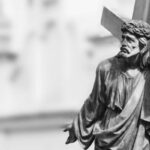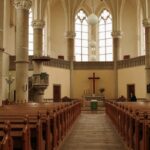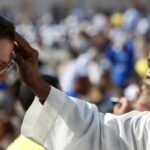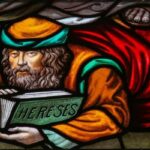We explain what Catholicism is, what its characteristics and beliefs are. In addition, we tell you its history and who was its founder.
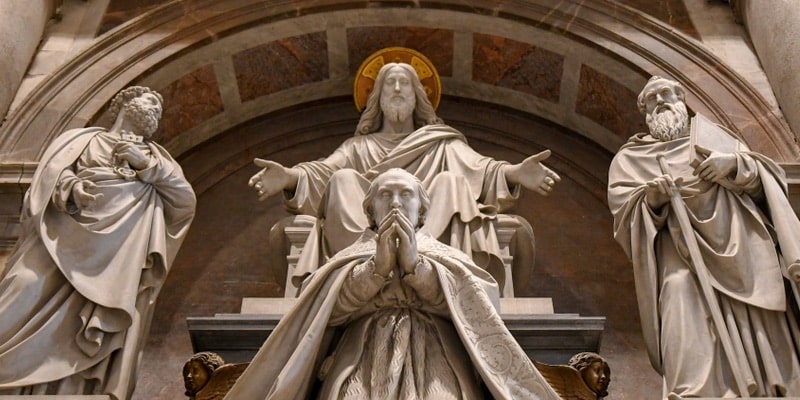
What is Catholicism?
Catholicism is one of the main branches or currents of the Christian religion. It is the largest church in terms of number of faithful and is made up of the Latin or Roman Church and 23 Eastern or Uniate churches (Catholic churches of Eastern tradition), all subject to the religious authority of the Pope, who resides in Vatican City. It is distinguished from the other two major branches of Christianity, which are Orthodoxy (separated from the Catholic Church in 1054) and Protestantism (originated with the Protestant Reformation in the 16th century).
Of the various currents of Christianity, Catholicism is the most uniform and organized. This is because the Catholic church It is an ancient, hierarchical and unified institution who considers herself the sole heir of the doctrine taught by Jesus of Nazareth, the Son of God in Christian dogma. In this sense, Catholicism has its origin in the figure of the apostle Peter, identified as the first pope to whom, according to the New Testament, Jesus said: “You are Peter (that is, Stone), and on this rock I will build my Church” (Matthew 16:18).
The term “Catholic” comes from late Latin catholicuswhich in turn comes from the Greek katholikós“universal”, and was a term adopted in the second century to refer to all Christian communities and congregations. Later, it began to be used to distinguish what was considered the “true” Christian church, established by Jesus Christ and the apostles, from dissident groups (considered heretical or schismatic).
Like other forms of Christianity, Catholics believe that Jesus of Nazareth was the Messiah foretold in Old Testament prophecies, and that his death constituted a sacrifice to free humans from sin and seal a new covenant between God and humanity. humanity.
Furthermore, Catholicism and other Christian currents believe that Jesus Christ was resurrected, appeared to the apostles and ascended to heaven, and that he will return, as announced in the biblical texts, and at that moment the final or universal judgment will take place. , in which only the faithful and righteous will be saved. However, Various aspects of Catholic doctrine are different from Orthodox and Protestant doctrines.
Catholicism It is the majority Christian current, with around 1.39 billion followers around the world (approximately 18% of the world's population), and a number of priests close to half a million. Furthermore, its historical and cultural role in the West has been central since before the fall of the Western Roman Empire, and it continues to be the main moral and religious doctrine of Mediterranean Europe and Latin America, and has a growing number of faithful in Africa and in Asia.
Key points
- Catholicism is the largest branch of Christianity, with around 1.39 billion followers worldwide.
- Its highest authority is the Pope, who presides over the Catholic Church from Vatican City.
- Its origin is usually located in the evangelical work of the apostles of Jesus in the 1st century AD. C., like Peter (considered the first pope) and Paul. Its consolidation occurred in the 4th century, when it became the official religion of the Roman Empire.
- He believes in the existence of one God and in the resurrection of Jesus Christ, and defends the doctrine of the Holy Trinity (God is one but manifests himself in three persons: the Father, the Son and the Holy Spirit).
- His sacred book is the Bible, he recognizes seven sacraments, venerates the saints and the Virgin Mary as intermediaries before God and believes in the future arrival of the final judgment.
- The Catholic Church had a significant impact on Western culture from Late Antiquity and the Middle Ages, especially in moral standards, politics, and art.
Characteristics of Catholicism
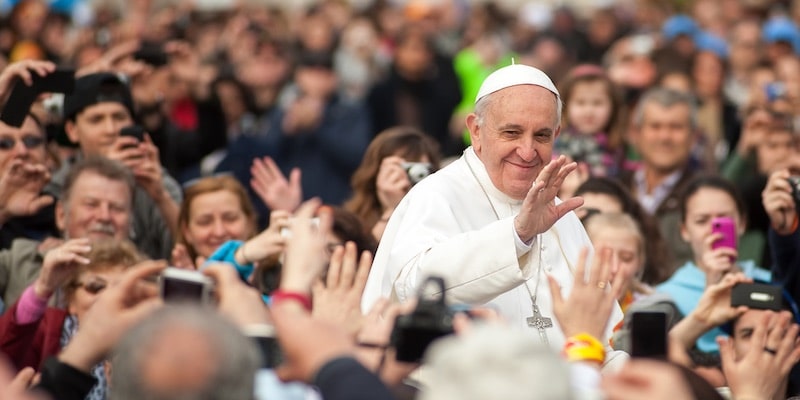
Broadly speaking, Catholicism is characterized by the following:
- It is the most numerous of the three main branches of Christianity (followed by Protestantism and Orthodoxy).
- Its doctrine is based on the belief in one God and in the person of Jesus Christ as the Son of God, crucified and resurrected on the third day to free human beings from sin.
- Its specific form of organization is the Catholic Church, whose highest authority is the Pope who is the bishop of Rome and heads the Holy See, established in Vatican City.
- Recognizes its origins in the preaching of Jesus Christ and the mission of his apostles and over more than two thousand years it developed a complex theological system and spread from the Middle East and Europe to different corners of the world.
- It is one of the majority religious currents in the world: its number of faithful is greater than the sum of the two Christian currents that follow it in number (Protestantism and Orthodoxy), and also exceeds the total number of Buddhists and Hindus. It is only surpassed in followers by Islam (and in particular by its Sunni branch).
- His doctrine exerted a fundamental influence on European and Western culture by establishing moral norms, promoting intellectual debates, inspiring artistic and architectural works and intervening in political affairs (such as legitimizing governments or unleashing wars and persecutions).
- Recognize seven sacraments: baptism, confirmation, the Eucharist, penance, anointing of the sick, priestly order and marriage. Catholics consider that these ritual practices were instituted by Jesus Christ to bring God's grace to believers.
- Their rites must be taught by priests trained and ordained for this purpose to whom celibacy is imposed as an obligation (except in the Eastern Catholic churches, in which the ordination of previously married men is admitted, except for the dignity of bishop).
- Its sacred text is Bible which includes the Old Testament (broadly equivalent to the Hebrew Bible) and the New Testament (the four canonical gospels, the Acts of the Apostles, a series of epistles, and the Apocalypse). However, there is also an extensive religious, mystical and theological bibliography developed over the centuries that is authoritative and is part of the Catholic tradition.
- Its rites come from those practiced in times of the Roman Empire although they experienced changes or adaptations over time, and currently the Roman rite and various Eastern rites exist. In addition, the pope is considered the direct successor of the apostle Peter, who is identified as the founder of the Church.
Origin and founder of Catholicism
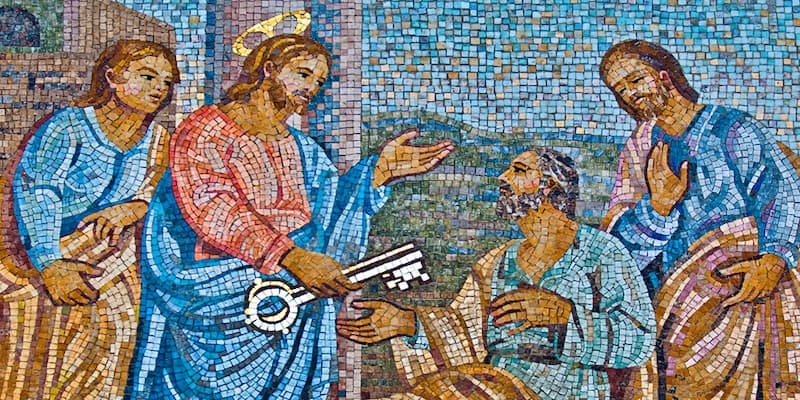
According to the Catholic Church, the origin of Catholicism dates back to the organization of the apostles of Christ for the preservation and dissemination of his legacy. According to tradition, The founder of the Catholic Church was the apostle Peter (also called Saint Peter) considered the first pope, who would have thus fulfilled the mission entrusted by Jesus Christ himself. This would have occurred in the 1st century AD. C., and would have formalized the separation between rabbinic Judaism and early Christianity.
As narrated in the Acts of the Apostles of the New Testament, this first organized church He began to spread his message to various cities, including Rome and began to address Gentile (non-Jewish) populations thanks to the apostolate of Paul of Tarsus, a Pharisee who converted to Christianity and who became known as the “Apostle to the Gentiles.” At the beginning of the second century, the bishop of Antioch, Ignatius, called this Church “catholic,” that is, universal.
The exact organization of this first Church varied in its first centuries, but maintained a three-tier organization (bishops, priests and deacons) at whose head was the bishop of Rome (considered the pope), since that was the capital of the Roman Empire.
Christianity was persecuted by the Romans until the year 313 when Emperor Constantine I published the Edict of Milan that established freedom of worship in the Roman Empire. This allowed Christianity to be practiced without prohibitions and to shape official worship through the celebration of ecumenical councils, such as the Councils of Nicaea (325), Ephesus (431) and Chalcedon (451).
In 380, Christianity became the official religion of the Roman Empire after the Edict of Thessaloniki decreed by Emperor Theodosius I. Within the framework of these councils and debates for the organization of the Catholic Church, some doctrines were condemned and different Christian variants were expelled, declared heretical (such as Arianism and Nestorianism ).
By the 5th century, the Catholic Church had spread throughout the Roman Empire, from Hispania to Syria and Africa, and the following centuries saw the evangelization of the rest of northern and eastern Europe. At that time, The Catholic Church was the only formal Christian church. It remained so until the Great Schism of 1054 also called the East-West Schism, which separated the Roman Apostolic Catholic Church (under the authority of the Pope, Bishop of Rome) from the Orthodox Catholic Church (predominant in the Eastern Mediterranean and Eastern Europe). Then it happened another major schism in the Catholic Church with the Protestant Reformation, which began in 1517 and gave rise to Protestantism.
Main beliefs of Catholicism
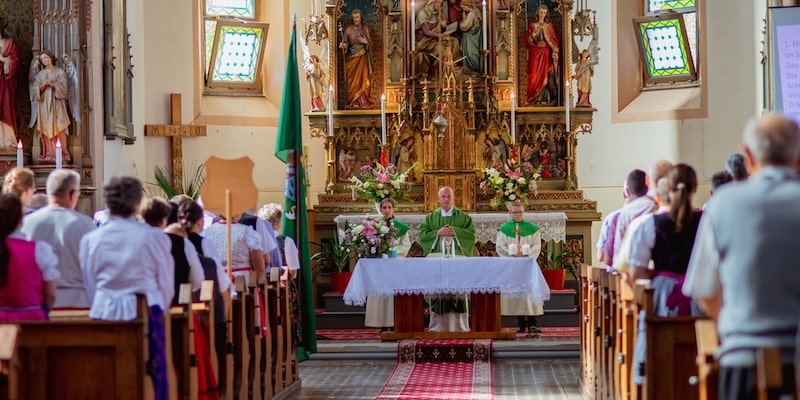
Catholicism It is based on the belief in one God and the dogma according to which Jesus Christ is the Son of God. According to this dogma, Jesus Christ was the Messiah sent by God to Earth to save humanity through his own sacrifice on the cross and to cleanse the sins of human beings and renew their covenant with God.
The most important aspect of this doctrine, which is shared by other Christian currents, is belief in the resurrection of Jesus Christ and his subsequent ascension to heaven. In this way, it is believed that believers who embrace faith in Christ will be prepared for the coming final judgment, in which the faithful will be rewarded with the resurrection of the body and eternal life in paradise, while the faithful will be punished. the guilty with the perpetual fire of hell.
The Catholic Church is the institution in charge of spreading this message and preparing the faithful for the encounter with God, a task carried out by priests, organized in a complex ecclesiastical hierarchy. To this end, the Church administers the seven sacraments which are considered to make present the grace of God:
- The baptism which through water initiates the faithful into the Catholic faith and purifies them and frees them from original sin.
- The confirmation which ratifies the believer's commitment to God before the community of the faithful and strengthens his Christian life.
- The Eucharist which recalls the last supper of Christ and, through the divine mystery of “transubstantiation”, converts the wine into the blood of the Messiah and the bread (the host) into his body, so that the faithful by consuming them become one with Christ.
- Penance which cleanses the faithful of sins committed after baptism, through confession and repentance, and allows their reconciliation with God.
- The anointing of the sick, or extreme unction which asks for the cure of the sick or prepares his spirit for his encounter with God.
- The priestly order which transmits the grace to exercise ministry to people who are ordained for ecclesiastical service.
- The marriage which consecrates the union of the couple under the precepts of Catholicism and is also a sign of the union of Christ with the Church.
On the other hand, Catholicism defends the unity of the Father, the Son and the Holy Spirit, that is, the Holy Trinity. This means that they consider that God is only one but manifests himself in three people: the Father (God), creator of the universe; the Son (Jesus), made flesh to suffer among human beings and sacrifice himself for their sins; and the Holy Spirit, present in the faithful to guide them towards mercy and eternal life.
The Catholic Church also venerates Christian martyrs and saints as intermediaries between God and the faithful. Martyrs are Christians who died because of defending faith in Christ and saints are deceased people that the Church decides to canonize (declare as saints) for having been martyred or for their religious virtues in life and alleged miracles in life or after death.
In this way, Catholicism has an extensive list of saints made up of blesseds (a step prior to canonization) and saints that continues to expand as the Holy See decides to beatify or canonize a deceased person. In Catholic churches It is normal to venerate images of these saints, as well as the Virgin Mary the mother of Christ according to the biblical story.
Distinction between Catholicism and Christianity
The difference between Catholicism and Christianity is that Christianity is the religion based on belief in Jesus Christ as the Messiah announced in the Old Testament and as the crucified and resurrected Son of God, while Catholicism is a particular form of Christianity which shares this core of beliefs with other churches and Christian denominations but has its own doctrines, authorities and liturgies.
That is, Catholicism is one of the three great branches of the Christian religion, and therefore should not be equated with the entirety of Christianity since Orthodoxy and Protestantism are, in turn, forms of Christianity, like other minority movements.
Differences between Catholicism and Protestantism
Protestantism emerged as a movement critical of Catholicism in the 16th century which called for the need to return to a purer and more original Christianity, that is, more similar to what was described in the ancient biblical texts. This need arose from accusations of corruption and departure from the true path directed against the Catholic Church, mainly by the German friar Martin Luther (1483-1546), who began the Protestant Reformation.
This movement was so powerful that led to the emergence of a diverse set of alternative churches, separate from the Catholic Church who came to be called “Protestants.” Although the Catholic Church tried to stop the advance of Protestantism through the so-called Counter-Reformation, Protestant congregations expanded to various countries around the world.
The main differences between Protestantism and Catholicism can be summarized as:
| Catholicism | Protestantism |
|---|---|
| The basis of its doctrine is the belief in Jesus of Nazareth as the Messiah and Son of God. It also venerates the Virgin Mary and the saints that make up the Catholic saints, considered capable of interceding for the faithful before God. | The foundation of its religious system is the belief in Jesus of Nazareth as the Messiah, the Son of God and the only possible intermediary between the parishioner and God. He considers Catholic veneration of saints and relics a form of idolatry. |
| Their churches usually have large altars with elaborate decorations on which images of saints and the crucified Jesus are displayed. | The altars of their churches are usually more discreet than the Catholic ones and do not reproduce images of saints. In many cases, the crucified Jesus Christ is not displayed either, but only the cross. |
| It considers the Bible as a sacred text, made up of the Old Testament (46 books) and the New Testament (27 books), and recognizes the religious authority of the tradition made up of the work of Christian theologians and mystics. | It considers the Bible as a sacred text, made up of the Old Testament (39 books) and the New Testament (27 books), and is generally distrustful of mystical texts and some interpretations of the Bible. |
| It recognizes seven sacraments: baptism, confirmation, the Eucharist (or communion), penance (or confession), anointing of the sick (or extreme unction), priestly orders and marriage. | It generally recognizes two sacraments: baptism and the Eucharist (sometimes called the Lord's Supper or Holy Supper), and some denominations practice believer's baptism (full immersion of the adult believer). |
| He understands his Church as universal and its spiritual leadership falls on the pope, successor of Saint Peter according to tradition. | Each church or movement understands its ministry as the true practice of the Gospel and there is no spiritual leader who unifies its doctrines. |
| The Catholic Church is a formal and hierarchical organization, which requires total dedication and celibacy from its priests. | The role of officiating the rites can be filled by any of the faithful, although it is often necessary to be invested, and ministers or pastors can marry. |
References
- Chadwick, H., & Evans, G.R. (1994). Christianity. Twenty centuries of history. Folio.
- Cunningham, L. (2009). An Introduction to Catholicism. Cambridge University Press.
- Cunningham, L. et al. (2024). Roman Catholicism. Encyclopedia Britannica. https://www.britannica.com/
- Filoramo, G., Massenzio, M., Raveri, M., & Scarpi, P. (2000). History of religions. Criticism.
- García Bazán, F. (2014). The papacy and the history of the Church. Ariadne's Thread

